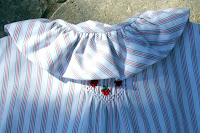Although the new pattern, Infant Wardrobe I, says you can use light weight denim, Patricia ran into a problem when making the jacket for her two year old grandson. This little guy lives out in Calgary, home of the world famous Calgary Stampede. Patricia envisioned the boy's view made up in sporty black denim with brilliant colours of native embroidery and set off with a T shirt, cowboy hat and boots. All went well until she went to set in the sleeves.
All patterns have limitations and a designer can not predict how every fabric will react. I want you to think beyond the Christening outfit and be creative. Don't be afraid to be challenged. There is always a solution.
The denim plus the lining proved rather bulky and the results were more like a puff sleeve which might have been fine for a little girl but not the tailored look she had planned.
So she brought it to me and asked what do I do now? The jacket was finished - buttons, buttonholes and embroidery all in tact - she didn't want to ruin it after all that work.
It was obvious to us both that there was simply too much fabric at this combined weight of denim and lining to allow the sleeve to fit smoothly into the armhole - so - a trim was needed!
By shaving three eighths of an inch from the cap and tapering it to nothing at the notches the amount of fabric would be reduced significantly and the angle of the sleeve in the garment only slightly altered. The notches were transferred to the new cutting line. The gathering threads would have been put in place again at one quarter inch and one half inch but I was not going to remove the whole sleeve from the jacket! If you were starting fresh that would be imperative but I knew that a technique from tailoring would work well in this case.


With this technique, you divide an area in half and pin. Then divide that area in half and pin. You keep doing this until you have no more room to place a pin or the fullness is used up. On the left you can see how the notch and the shoulder seam have been matched up and the area to the left has begun to be divided and pinned. On the right you can see my hands dividing the area to pin. Or you can fold the fabric in half, lining up the last two pins to find the centre of the sleeve and armhole. This is more accurate in the beginning when you are working with a large area. As you get down to less fullness you can see how much fullness you have to divide and pin.

Here you see the sleeve pinned in place. There is no more room for any more pins because of the bulkiness of the fabric. Next I hand basted the sleeve in place. Yes, hand basted! with a back stitch to get the most control. Back stitched because I had to use stitch that I could 'pick and poke' to get the gathers eased out. Had I gone to the trouble of putting in the gathering threads once again, I could have pulled them up and eased the fullness further. But I didn't, so hand basting was imperative! And I might say it worked perfectly.
So here you can see the finished seam and how I am easing in the fullness of the raw edge as I overcast with a zigzag stitch. I used a trolley needle to hold the gathered down and in place as the fabric passed under the machine foot. When the seam allowance is pressed into the sleeve it acts as a support for the sleeve cap and helps it to sit properly.
Oh, but you are not finished yet! Setting the finished sleeve with a bath of steam is important. Steam works best as you won't have any shine from the iron. If you don't have a tiny sized pressing ham or the sleeve won't fit over the end of you sleeve board, create a ball-shaped support from a towel or a couple of washcloths. This needs to be pretty firm though so it may take a bit of 'finaggling' to get something to fit into the sleeve cap area. If the jacket had been made of wool the sleeve could be set with steam alone and all fullness worked out. But with cotton denim (which stretches!) a good bath of steam with the support to shape it all will work well. Remember that it is a child's garment and will be washed often so don't over stress yourself! I just have a tendency to want perfection.
So here you can see the finished product. I think you will agree it looks much better and Patricia was happy with the results.
Every fabric is a learning experience and I can hardly wait to see the photos of this little guy all decked out in his Western version of the Infant Wardrobe. I will post photos as soon as she send them so watch here in the next couple of weeks.
Until next time then - you know the drill - keep stitching!!!!


















































